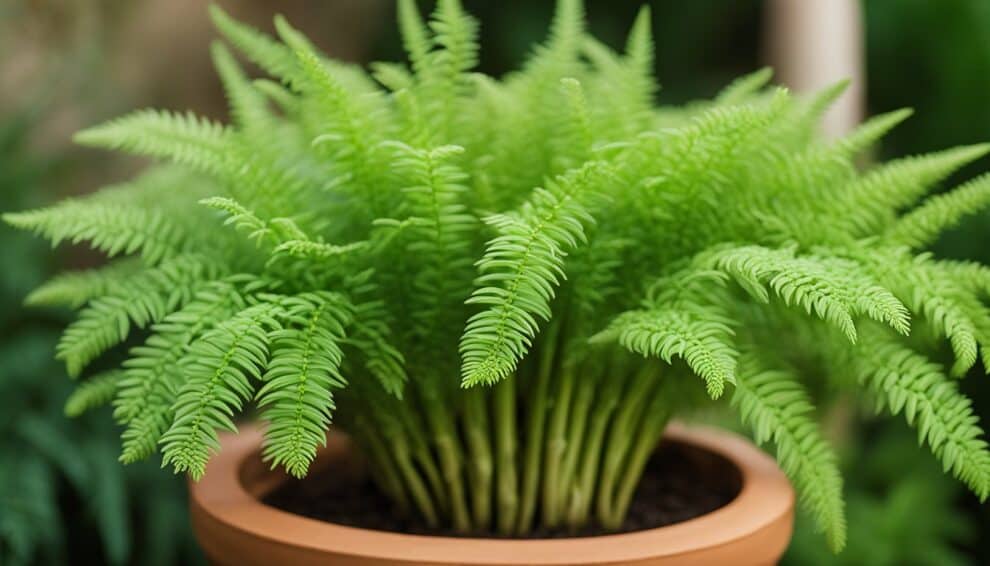Foxtail fern, also known as Asparagus densiflorus ‘Myers’, is a popular houseplant among garden enthusiasts.
This plant is native to South Africa and belongs to the Asparagaceae family.
It is a great addition to any indoor garden due to its unique appearance and low maintenance requirements.

The foxtail fern gets its name from its bushy, tail-like fronds that resemble a fox’s tail.
Its foliage is a bright green color and is made up of small, needle-like leaves.
This plant is also known for producing small, white flowers that bloom in the summer months.
While it is a slow-growing plant, it can reach up to 2-3 feet in height and spread up to 4-5 feet wide.
For beginner gardeners, the foxtail fern is an excellent choice as it is easy to care for and requires minimal attention.
With the right care, this plant can thrive indoors and add a touch of greenery to any living space.
In this article, we will explore some care tips for the foxtail fern, including its watering, light, and soil requirements, to help beginners keep their plant healthy and happy.
Getting to Know Foxtail Fern
Foxtail fern, also known as Asparagus densiflorus ‘Myers’, is a beautiful and unique plant that can add a touch of elegance to any room or garden.
It is a member of the lily family and is native to South Africa.
The plant gets its name from its bushy, fern-like foliage that resembles a fox’s tail.
Foxtail fern is a hardy and low-maintenance plant, making it an excellent choice for beginners.
It can grow up to 2 feet tall and 3 feet wide, and it produces small white flowers in the summer.
The plant is also known for its bright red berries that appear in the fall and winter.
One of the great things about foxtail fern is its versatility. It can be grown in containers or in the ground, and it thrives in both sun and shade.
It is also drought-tolerant, making it ideal for those who live in dry climates.
To care for your foxtail fern, it is important to keep the soil moist but not waterlogged.
The plant prefers well-draining soil, so be sure to choose a pot with drainage holes if you are growing it in a container.
Fertilize your foxtail fern once a month during the growing season with a balanced fertilizer.
In summary, foxtail fern is a unique and low-maintenance plant that can add beauty and elegance to any space.
With a little care and attention, it can thrive and bring joy for years to come.
Essential Care Tips

Lighting Requirements
The Foxtail Fern requires bright, indirect light to thrive.
Direct sunlight can scorch its leaves, so it’s best to place it near a window that receives filtered light.
If the plant is not getting enough light, it will become leggy and the leaves will turn yellow, so make sure to adjust its location accordingly.
Watering Practices
The Foxtail Fern prefers to be kept moist, but not waterlogged. Water the plant when the top inch of soil feels dry to the touch.
During the growing season, which is typically spring and summer, the plant may need to be watered more frequently.
However, in the winter months, when the plant is dormant, it will require less water.
Avoid getting water on the foliage, as this can lead to fungal diseases.
Soil and Fertilization
The Foxtail Fern prefers well-draining soil that is rich in organic matter.
A good potting mix for this plant would be a blend of peat moss, perlite, and vermiculite.
Fertilize the plant every two to three weeks during the growing season with a balanced, water-soluble fertilizer.
Avoid fertilizing the plant during the winter months.
Temperature and Humidity
The Foxtail Fern prefers temperatures between 60-75°F (15-24°C). It can tolerate slightly cooler temperatures, but it is not frost-tolerant.
The plant also prefers high humidity, so it’s a good idea to mist it regularly or place a humidifier near it.
If the air is too dry, the plant may develop brown tips on its leaves.
Propagation and Repotting

Propagation Methods
Foxtail ferns can be propagated through division or spores. Division is the most common method and is best done in spring or early summer.
To propagate through division, carefully remove the plant from its pot and gently separate the root ball into smaller sections.
Ensure that each section has a good amount of roots and foliage. Replant each section in a well-draining potting mix and water thoroughly.
To propagate through spores, wait until the fern produces small, brown spores on the undersides of its fronds.
Collect the spores and sow them in a container filled with moist, well-draining potting mix.
Cover the container with plastic wrap to create a humid environment and place it in a bright, warm spot. The spores will germinate within a few weeks.
Repotting Steps
Foxtail ferns should be repotted every two to three years to ensure healthy growth.
Repotting is best done in spring, just before the plant enters its active growing season.
To repot, carefully remove the plant from its pot and gently loosen any tangled or circling roots.
Choose a new pot that is one size larger than the current pot and fill it with a well-draining potting mix.
Place the plant in the new pot and backfill with potting mix, ensuring that the plant is at the same height as before.
Water thoroughly and allow the plant to settle in its new pot for a few days before resuming regular care.
Common Issues and Management

Pests and Diseases
Foxtail ferns are relatively pest-resistant, but they can still fall prey to a few common pests.
Spider mites and mealybugs are the most likely culprits, but they can be easily controlled with insecticidal soap or neem oil.
It’s important to keep an eye out for these pests, as they can quickly spread to other plants if left unchecked.
Diseases are less common, but can still occur.
Root rot is a possibility if the plant is overwatered, so it’s important to make sure the soil is well-draining and not constantly moist.
Leaf spot and rust can also occur, but can be prevented by avoiding overhead watering and ensuring good air circulation around the plant.
Handling Browning Leaves
Browning leaves are a common issue with foxtail ferns, but they can be easily managed with a few simple steps.
First, make sure the plant is not getting too much direct sunlight, as this can cause the leaves to dry out and turn brown.
If the plant is in a sunny location, consider moving it to a shadier spot.
Second, make sure the plant is getting enough water. Foxtail ferns prefer to be kept consistently moist, but not soaking wet.
If the soil is dry to the touch, it’s time to water the plant.
Finally, if the browning leaves are particularly unsightly, they can be trimmed off with a sharp pair of scissors.
This will not harm the plant, and will encourage new growth.
Frequently Asked Questions

What are the best practices for overwintering a Foxtail Fern?
Foxtail ferns are hardy plants that can tolerate a wide range of temperatures.
However, during the winter months, it is best to provide them with some protection.
If you live in a cold climate, consider moving your foxtail fern indoors or covering it with a frost cloth.
Make sure to keep the soil moist but not waterlogged.
Can I grow a Foxtail Fern in a pot, and if so, how?
Yes, foxtail ferns can be grown in pots.
When choosing a pot, make sure it has good drainage holes and is large enough to accommodate the plant’s root system.
Use a well-draining potting mix and water the plant when the top inch of soil feels dry.
Fertilize the plant every two to three months during the growing season.
Are there any toxicity concerns with Foxtail Ferns around pets or children?
Foxtail ferns are non-toxic to pets and children, making them a great choice for households with furry friends or little ones.
What is the proper method for propagating Foxtail Ferns using water?
To propagate a foxtail fern using water, cut a healthy stem from the parent plant and remove the lower leaves.
Place the stem in a jar of water, making sure the bottom of the stem is submerged.
Change the water every few days and wait for roots to form before transplanting the cutting into soil.
Should I keep my Foxtail Fern indoors or outdoors for optimal growth?
Foxtail ferns can be grown both indoors and outdoors. If you live in a warm climate, you can grow them outside year-round.
In colder climates, it is best to move them indoors during the winter months.
What steps should I follow for successful indoor care of a Foxtail Fern?
To care for a foxtail fern indoors, place it in a bright, indirect light and keep the soil moist but not waterlogged.
Fertilize the plant every two to three months during the growing season and prune as needed to maintain its shape.














